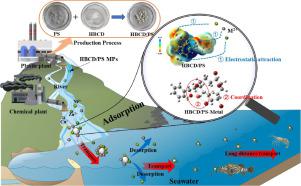Water Research ( IF 11.4 ) Pub Date : 2022-09-23 , DOI: 10.1016/j.watres.2022.119144 Lujian Lin 1 , Hanyi Li 1 , Hualong Hong 1 , Bo Yuan 1 , Xuan Sun 2 , Le He 1 , Chengwen Xue 1 , Haoliang Lu 1 , Jingchun Liu 1 , Chongling Yan 3

|
Microplastics (MPs) are known to act as carriers of heavy metals; however, little is known about the intrinsic chemical additives of MPs, such as hexabromocyclododecane (HBCD), in terms of the adsorption behaviors and migration risks of heavy metals on MPs. Here, we reported the potential mechanisms and risks of HBCD inherent in polystyrene (PS) MPs with Cu(II), Ni(II), and Zn(II) adsorption/desorption. A comparison of the adsorption capacity of the metals onto HBCD/PS composites (HBCD/PS) MPs (10.31–20.76 μmol/g), pure MPs (0–3.60 μmol/g), and natural minerals (0.11–13.88 μmol/g) showed that the addition of HBCD significantly promoted the metals adsorption onto the HBCD/PS MPs, and even exceeded that of natural particles. Isotherms and thermodynamic data suggested that the adsorption process of the metals onto the HBCD/PS MPs was spontaneous and endothermic, and that the adsorption was a mainly multi-ion process with an inclined direction. Furthermore, the results of SEM-EDS, FTIR, and XPS analyses, as well as density functional theory well explained that the metals were mainly adsorbed on the –O and –Br groups of the HBCD/PS MPs via electrostatic interactions and surface complexation. More importantly, by comparing the desorption activity with natural river water and seawater, HBCD inherent in MPs can enhance the long-range transfer of metals carried by the HBCD/PS MPs from contamination sources to potential sink like oceans. Thus, the HBCD/PS MPs with high loading of Cu(II), Ni(II), and Zn(II) could be potential secondary sources of these metals in seawater. Overall, these findings revealed the potential risks of flame retardant in MPs associated with metal migration, and advocated that flame retardant-related waste MPs should be included in coastal sustainable development.
中文翻译:

通过加入阻燃剂六溴环十二烷增强微塑料对重金属的吸附:机理和潜在迁移风险。
众所周知,微塑料 (MP) 是重金属的载体;然而,就重金属在 MPs 上的吸附行为和迁移风险而言,人们对 MPs 的内在化学添加剂(如六溴环十二烷 (HBCD))知之甚少。在这里,我们报告了聚苯乙烯 (PS) MP 中固有的六溴环十二烷的潜在机制和风险,其中包含铜 (II)、镍 (II) 和锌 (II) 吸附/解吸。金属对 HBCD/PS 复合材料 (HBCD/PS) MPs (10.31–20.76 µmol/g)、纯 MPs (0–3.60 µmol/g) 和天然矿物 (0.11–13.88 µmol/g) 的吸附能力比较) 表明,HBCD 的添加显着促进了金属对 HBCD/PS MPs 的吸附,甚至超过了天然颗粒的吸附。等温线和热力学数据表明,金属在HBCD/PS MPs上的吸附过程是自发的和吸热的,吸附主要是一个倾斜方向的多离子过程。此外,SEM-EDS、FTIR 和 XPS 分析以及密度泛函理论的结果很好地解释了金属主要通过静电相互作用和表面络合吸附在 HBCD/PS MP 的 -O 和 -Br 基团上。更重要的是,通过将解吸活性与天然河水和海水进行比较,MPs 中固有的 HBCD 可以增强 HBCD/PS MPs 携带的金属从污染源到海洋等潜在汇的远程转移。因此,具有高负载 Cu(II)、Ni(II) 和 Zn(II) 的 HBCD/PS MP 可能是这些金属在海水中的潜在次要来源。







































 京公网安备 11010802027423号
京公网安备 11010802027423号